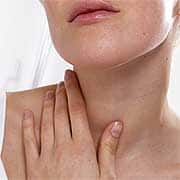Life Extension Magazine®
| While skin care products help maintain a youthful face, an individual’s age is all too often revealed by unsightly changes that are seen in the neck. In fact, many dermatologists believe that the neck has become one of the most neglected parts of the body.
The skin of the neck is very thin, and is constantly exposed to the merciless pounding of environmental agents and pollutants, including the ultraviolet (UV) rays that are primarily responsible for premature aging. Despite these ubiquitous stressors, many of us stop our skin-care regimes at our chins. That’s why so many of us end up with youthfullooking faces sitting on top of older-looking necks. Cosmetics can work wonders on your face, but provide only limited help against an aging neck. Surgical procedures, as well, leave much to be desired. There are topical ingredients, however, that scientific studies show do work. Here, we take a look at today’s most advanced topical nutrients for promoting optimal skin health of the neck.
Mechanisms of Skin AgingAs you grow older, your accumulated exposure to UV radiation and environmental pollutants cause the breakdown of healthy collagen fibers and the production of abnormal elastin. When enough of this damage accumulates, special enzymes called metalloproteinases are released.1 These enzymes help remodel your sun-traumatized skin by manufacturing and rebuilding new collagen. Unfortunately, they do not always work very well, and some of them actually end up breaking down collagen instead. When your skin repeats this process over and over, it results in the formation of weak, disorganized collagen fibers that eventually collapse, causing your skin to droop. All too often, the result is wrinkling and sagging skin, particularly in the neck. Fortunately, topical nutrients can help fight skin aging at its very roots. By firming skin, reducing hyperpigmentation, restoring moisture, boosting collagen production, and fighting oxidative damage, these novel agents can help to restore and maintain the appearance of a youthful neck. Acetyl Hexapeptide-3: Relieving Prominent Neck BandsAcetyl hexapeptide-3 is a patented amino peptide2 that is easily absorbed by your skin. Once inside, it gets right to work influencing muscle relaxation. The effect of this amino peptide can be fairly dramatic. In one study, a 10% concentration of acetyl hexapeptide-3 was proven to reduce the depth of wrinkles by up to 30% after just 30 days.3 This molecule works by reducing the excess production of transmitters that control facial muscle contraction, which is an underlying cause of wrinkles. Before muscle cells can contract, they must receive a signal from neurons (brain cells). In order for the neurons to send such a signal, a group of three proteins (known as the SNARE complex) must form a zipper-like connection that leads to the release of transmitters. Acetyl hexapeptide-3 mimics one of these three essential proteins, called SNAP-25, which is needed for transmitter release at the nerve junctions (synapses). By competing with SNAP-25 for a position in the SNARE complex, acetyl hexapeptide- 3 interferes with this zipperlike connection, effectively blocking the chemical signal for muscles to contract. Scientists believe that preventing transmitter release may attenuate muscle contraction, promoting a smoother appearance of neck muscles. This also softens the look of vertical banding caused by the platysma muscle that is often so pronounced in aging necks, and also helps minimize those visible folds and creases.3,4 Hydrate with Hyaluronic AcidBeneath the surface of your skin, there lies a framework of connective tissue. This collagen forms a triplehelix, rope-like structure that creates a vital support for your skin above. It is made up of protein organized in bundles, which are anchored to each other at right angles by inter-fiber cross linkages. This fiber network is held in place by a jelly-like extracellular matrix made up of water, protein complexes and a substance called hyaluronic acid. The ability of hyaluronic acid to attract and retain water (1000 times its own weight) is unmatched by any other substance in nature. This is very important because the links in your collagen network are like those of a net cast into the sea that are kept open only in the presence of water. Without the volumizing effect of this large, sugar-like molecule on your extracellular matrix, collagen fibers just end up collapsing. Gravity pulling down on the loosened skin of the neck does the rest. As if this were not enough, the hyaluronic acid-dependent extracellular matrix is also responsible for transporting essential nutrients from your bloodstream to the living cells of your skin, making it crucial for maintaining the skin’s softness and moisture. Although younger skin has an abundance of hyaluronic acid, free radical damage caused by UV radiation gradually depletes hyaluronic acid reserves. In fact, by the time you reach your 50th birthday, you’ve already lost close to half of it. Replenishing skin with hyaluronic acid increases cell renewal and rejuvenation,5 helps restore healthy texture, color, and moisture to your aging neck, and plays an important role in the way your skin looks, feels, and functions. Revitalize and Rebuild with RetinolRetinol (the purest form of vitamin A) has been clinically proven to inhibit the increase of collagendegrading substances called matrix metalloproteinases (MMPs).1 In addition, scientific studies have shown that this nutrient encourages new collagen formation by helping re-stimulate your fibroblasts’ growth potential,6 which diminishes with age. Retinol can even increase the epidermal thickness of your skin.7 The reason retinol works so well is because it is one of the few substances with a molecular structure small enough to penetrate the protective outer layer of your skin. Once inside, retinol is enzymatically converted into retinoic acid—its active metabolite. Skin cells have receptor sites that are very accepting of retinoic acid. This key relationship between retinoic acid and the binding receptor sites of your skin sets up a type of DNA communication in which your cells are encouraged to function normally and continue the regular process of cell renewal.8,9 Because of its unique ability to strengthen and rejuvenate your skin, as well as its effect in stimulating new collagen production, retinol is able to diminish the overall appearance of unsightly creases and folds from the inside out, leaving your neck looking naturally smoother, younger, and healthier. Eliminate Age Spots with N-Acetyl Glucosamine and NiacinamideFrom the age of 40 onwards, your skin is less able to regenerate pathological changes induced by sun exposure. Ordinarily, sunlight triggers special skin cells called melanocytes to release greater amounts of a brownblack pigment called melanin into your skin. Melanin limits the amount of UV light that penetrates the epidermal layer of skin. The darker pigmentation produced by melanin also helps protect your skin from further damage by making it harder for the skin to burn. With advancing age and accruing sun exposure, these active melanocytes begin to cluster together, producing unsightly, mottled areas of hyperpigmentation where the melanin pools beneath the skin. N-acetyl glucosamine, a more stable version of glucosamine, inhibits the activation of tyrosinase—an enzyme involved in the overproduction of melanin in UV-damaged skin cells.10 Niacinamide (also known as nicotinamide) is a water-soluble form of vitamin B3 that appears to work by inhibiting the transfer of melanin from melanocytes to epidermalskin cells.11 Topical niacinamide has been scientifically shown to reduce the yellowing, crinkling, blotchiness, and hyperpigmentation of aging skin.12 However, when used together, N-acetyl glucosamine and niacinamide are much more effective at reducing hyperpigmentation than either one alone. Treatment with N-acetyl glucosamine and niacinamide results in both a reduction of hyperpigmented spot size and an improved consistency in melanin distribution.13 These two powerful skin-lightening agents work synergistically to markedly improve the health and appearance of aged neck skin. | ||||
Antioxidant Benefits of Tea
Free radical damage to your skin is a leading cause of premature aging. The potent natural antioxidants found in white, green, black, and red tea extracts help reduce the inflammation and oxidative stress that can destroy the health of your skin cells.14-16 Red tea in particular possesses a very impressive antioxidant capacity.14 Tea extracts also enhance the powerful, free radicalquenching capabilities of vitamin E17 and provide the protective strength of epigallocatechin-3-gallate (EGCG), which can even guard your skin from the ravages of UV exposure and DNA damage.18 In addition, green tea may enhance intracellular superoxide dismutase (antioxidant) activity and increase total plasma antioxidant activity.19 Furthermore, the vitaminC activity of tea extracts20 may contribute to the formation of new collagen,21,22 improving both your skin tone and structure. The outstanding free radicalquenching ability of topical tea extracts and their many benefits in countering the normal effects of aging make them highly desirable ingredients in any skin-care regimen. Energize and Firm the SkinOther notable ingredients that offer proven rejuvenating benefits for your skin when used topically include coenzyme Q10 (CoQ10), alpha-lipoic acid, and dimethylaminoethanol (DMAE). The antioxidants CoQ10 and alpha-lipoic acid are highly effective in countering the normal decline in mitochondrial energy production that accompanies aging.23 These nutrients are especially important for aging skin due to their essential role in promoting youthful skin cell structure and function.24,25 Another nutrient that fights sagging caused by the destruction of the skin’s underlying collagen structure is DMAE. This has been shown to produce a firming effect on the skin,26 and, based on clinical reports, it may be the first topical agent that can help firm sagging skin directly.27,28 DMAE also greatly increases the skin’s radiance and tone. Put It All TogetherIt is now possible to rejuvenate the aging skin of your neck—without resorting to invasive surgical procedures. Remarkable topical nutrients such as acetyl hexapeptide-3, hyaluronic acid, retinol, N-acetyl glucosamine, niacinamide, CoQ10, concentrated tea extracts, alphalipoic acid, and DMAE help protect, repair, and strengthen your skin, while lessening the appearance of hyperpigmentation and vertical banding. These topical ingredients also help hydrate and revitalize dry-looking skin, firm and tighten sagging areas, and reduce the appearance of creases and folds. By applying these advanced topical agents one to two times daily, you can relieve the tell-tale signs of aging and achieve a firmer, more youthful-looking neck. If you have any questions on the scientific content of this article, please call a Life Extension Health Advisor at 1-800-226-2370. | |
| References | |
| 1. Varani J, Warner RL, Gharaee-Kermani M, et al. Vitamin A antagonizes decreased cell growth and elevated collagen-degrading matrix metalloproteinases and stimulates collagen accumulation in naturally aged human skin. J Invest Dermatol. 2000 Mar;114(3):480-6. 2. Ruiz MA, Clares B, Morales ME, Cazalla S, Gallardo V. Preparation and stability of cosmetic formulations with an antiaging peptide. J Cosmet Sci. 2007 Mar- Apr;58(2):157-71. 3. Blanes-Mira C, Clemente J, Jodas G, et al. A synthetic hexapeptide (Argireline) with antiwrinkle activity. Int J Cosmet Sci. 2002;24(5):303-10. 4. Available at: http://query.nytimes.com/gst/ fullpage.html?res=9E02EED61239F931A15 755C0A9629C8B63&sec=health. Accessed August 29, 2007. 5. Li L, Asteriou T, Bernert B, Heldin CH, Heldin P. Growth factor regulation of hyaluronan synthesis and degradation in human dermal fibroblasts: importance of hyaluronan for the mitogenic response of PDGF-BB. Biochem J. 2007 Jun 1;404(2):327-36. 6. Hornberg JJ, Dekker H, Peters PH, et al. Epidermal growth factor receptor-induced activator protein 1 activity controls densitydependent growth inhibition in normal rat kidney fibroblasts. Mol Biotechnol. 2006 Oct;34(2):101-8. 7. Duell EA, Kang S, Voorhees JJ. Unoccluded retinol penetrates human skin in vivo more effectively than unoccluded retinyl palmitate or retinoic acid. J Invest Dermatol. 1997 Sep;109(3):301-5. 8. Roos TC, Jugert FK, Merk HF, Bickers DR. Retinoid metabolism in the skin. Pharmacol Rev. 1998 Jun;50(2):315-33. 9. Ross AC. Overview of retinoid metabolism. J Nutr. 1993 Feb;123(2 Suppl):346-50. 10. Bissett DL. Glucosamine: an ingredient with skin and other benefits. J Cosmet Dermatol. 2006 Dec;5(4):309-15. 11. Hakozaki T, Minwalla L, Zhuang J, et al. The effect of niacinamide on reducing cutaneous pigmentation and suppression of melanosome transfer. Br J Dermatol. 2002 Jul;147(1):20-31. 12. Greatens A, Hakozaki T, Koshoffer A, et al. Effective inhibition of melanosome transfer to keratinocytes by lectins and niacinamide is reversible. Exp Dermatol. 2005 Jul;14(7):498-508. 13. Bissett DL, Robinson LR, Raleigh PS, et al. Reduction in the appearance of facial hyperpigmentation by topical N-acetyl glucosamine. J Cosmet Dermatol. 2007 Mar;6(1):20-6. 14. McKay DL, Blumberg JB. A review of the bioactivity of South African herbal teas: rooibos (Aspalathus linearis) and honeybush (Cyclopia intermedia). Phytother Res. 2007 Jan;21(1):1-16. 15. Ojo OO, Ladeji O, Nadro MS. Studies of the antioxidative effects of green and black tea (Camellia sinensis) extracts in rats. J Med Food. 2007 Jun;10(2):345-9. 16. Gawlik M, Czajka A. The effect of green, black and white tea on the level of alpha and gamma tocopherols in free radicalinduced oxidative damage of human red blood cells. Acta Pol Pharm. 2007 Mar- Apr;64(2):159-64. 17. Kuchide M, Tokuda H, Takayasu J, et al. Cancer chemopreventive effects of oral feeding alpha-tocopherol on ultraviolet light B induced photocarcinogenesis of hairless mouse. Cancer Lett. 2003 Jul 10;196(2):169-77. 18. Katiyar SK. Skin photoprotection by green tea: antioxidant and immunomodulatory effects. Curr Drug Targets Immune Endocr Metabol Disord. 2003 Sep;3(3):234-42. 19. Li YM, Chan HY, Huang Y, Chen ZY. Green tea catechins upregulate superoxide dismutase and catalase in fruit flies. Mol Nutr Food Res. 2007 May;51(5):546-54. 20. du Toit R, Volsteedt Y, Apostolides Z. Comparison of the antioxidant content of fruits, vegetables and teas measured as vitamin C equivalents. Toxicology. 2001 Sep 14;166(1-2):63-9. 21. Wha Kim S, Lee IW, Cho HJ, et al. Fibroblasts and ascorbate regulate epidermalization in reconstructed human epidermis. J Dermatol Sci. 2002 Dec;30(3):215-23. 22. Bell E, Rosenberg M, Kemp P, et al. Recipes for reconstituting skin. J Biomech Eng. 1991 May;113(2):113-9. 23. Rodriguez MC, MacDonald JR, Mahoney J, Parise G, Beal MF, Tarnopolsky MA. Beneficial effects of creatine, CoQ10, and lipoic acid in mitochondrial disorders. 24. Blatt T, Lenz H, Koop U, et al. Stimulation of skin’s energy metabolism provides multiple benefits for mature human skin. Biofactors. 2005;25(1-4):179-85. 25. Han B, Nimni ME. Transdermal delivery of amino acids and antioxidants enhance collagen synthesis: in vivo and in vitro studies. Connect Tissue Res. 2005;46(4- 5):251-7. 26. Uhoda I, Faska N, Robert C, Cauwenbergh G, Piérard GE. Split face study on the cutaneous tensile effect of 2- dimethylaminoethanol (deanol) gel. Skin Res Technol. 2002 Aug;8(3):164-7. 27. Morissette G, Germain L, Marceau F. The antiwrinkle effect of topical concentrated 2-dimethylaminoethanol involves a vacuolar cytopathology. Br J Dermatol. 2007 Mar;156(3):433-9. 28. Grossman R. The role of dimethylaminoethanol in cosmetic dermatology. Am J Clin Dermatol. 2005;6(1):39-47. |



